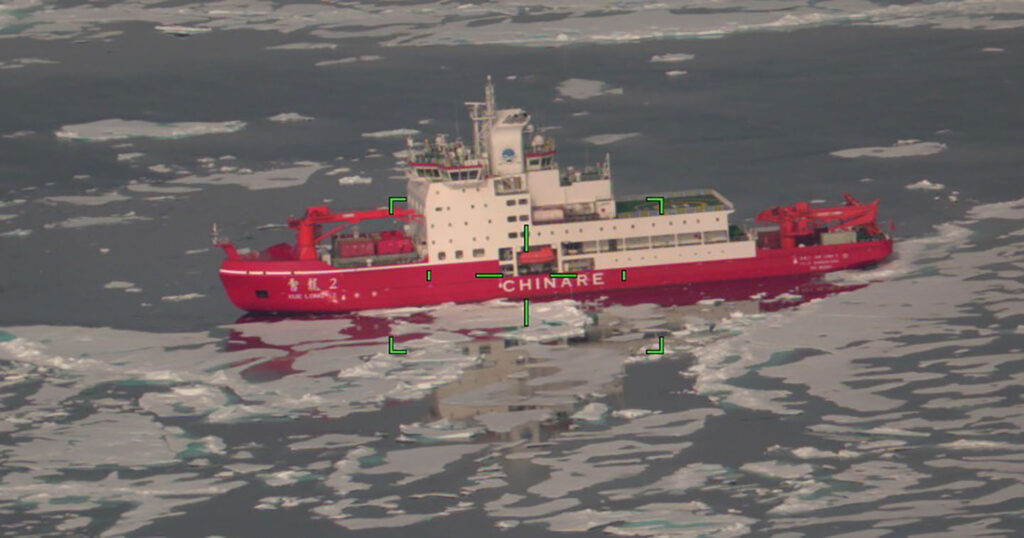The United States Northern Command (USNORTHCOM) and the U.S. Coast Guard have been “naming and shaming” Chinese Communist Party (CCP) vessels near Alaska in recent months. The latest CCP ships in question appear to be research vessels operating from July through September in the extended continental shelf when Coast Guard vessels intercepted them. The CCP activity indicates a more aggressive posture in the U.S. Arctic region.
U.S. forces closely monitored and tracked the ships, much like they would CCP planes in the Alaska Defense Identification Zone (ADIZ) or CCP naval vessels in the area. USNORTHCOM and Coast Guard officials did not hesitate to publicly denounce the CPP activity. Their public comments were meant to educate the public about the CCP activity and the potential threat it poses to the U.S. “Not only is it testing the resolve of the U.S. in this space, but it’s also trying to normalize presence,” Daniel White, a former DHS official, told Breaking Defense, a U.S. military affairs news site, about the CCP activity in the U.S. Arctic. “I think that is really what is important for [North American Aerospace Defense Command] and NORTHCOM and the Coast Guard, as far as naming and shaming.”
The Coast Guard cutters intercepted CCP ships in July, August and September. In all, eight CCP-linked vessels were spotted in the extended continental shelf (ECS) north of Alaska. As the CCP icebreaker Xue Long 2 operated about 130 nautical miles inside the ECS, a Coast Guard C-130J Hercules fixed-wing aircraft from Air Station Kodiak responded on July 26. “The U.S. has exclusive rights to conserve and manage the living and non-living resources of its ECS,” stated a Coast Guard news release. A former Department of Homeland Security official told Breaking Defense that the Coast Guard responded to the CCP incursion because “it signals that the United States views this as a gray zone activity, not a military threat requiring escalation or a defense-oriented response.”
The official continued: “When Russian aircraft approach the Alaska Air Defense Identification Zone, for example, NORTHCOM typically responds by scrambling jets or repositioning forces, which often results in military-to-military communication. … In contrast, this situation remains within the Coast Guard’s purview: observing, asserting legal authorities, and enforcing maritime norms without crossing into the defense domain.”
In August, five more CCP ships were sighted in the area. The Coast Guard again dispatched a C-130J Hercules to monitor the ships. “The Arctic is a growing zone of strategic global competition. The Coast Guard is the only U.S. surface presence in the Arctic and recently, in Alaska, commissioned U.S. Coast Guard Cutter Storis (WAGB 21), the service’s newest polar icebreaker, and U.S. Coast Guard Cutter Earl Cunningham (WPC 1159), the newest Sentinel-class fast response cutter. Commissioning the Storis and Earl Cunningham increases our ability to control, secure, and defend Alaska’s U.S. border and maritime approaches,” stated Rear Adm. Bob Little, commander, U.S. Coast Guard Arctic District, in an August 16 news release. “As we continue to grow our surface fleet, we utilize our aviation resources which play a vital role in countering foreign malign influence.”
The U.S. Coast Guard responded to two Chinese research ships operating near Alaska in late August and early September about 250 nautical miles northwest of Utqiagvik. This time, the Coast Guard dispatched its USCG Healy icebreaker to meet the ships along with a C-130J Hercules. “This operation highlights the value of our ice-capable fleet,” Little said in a September 3 news release. “The U.S. Coast Guard is controlling, securing, and defending the northern U.S. border and maritime approaches in the Arctic to protect U.S. sovereignty, and Healy’s operations demonstrate the critical need for more Coast Guard icebreakers to achieve that.” The Healy and the HC-130J aircraft were operating under Coast Guard Arctic District’s Operation Frontier Sentinel, which is designed to counter adversary activity in U.S. waters. The Coast Guard continues to monitor ongoing Chinese activity in the region, according to the release.
Although the Coast Guard has taken the lead in confronting CCP adversarial activity, USNORTHCOM and North American Aerospace Defense Command Commander Gregory Guillot told Breaking Defense that the CCP has stepped up its aggressive behavior since 2021. From that year until 2024, the CCP conducted naval patrols in the region, twice sailing with Russian naval ships. “The increase in activity stems from China’s construction of new polar research ships and Beijing’s aim to expand its influence and access in the Arctic,” he said. Guillot noted that the CCP “conducted its first ever air patrol inside” the Alaskan ADIZ, when two H-6 medium bombers and two Russian Tu-95 heavy bombers overflew the Bering Sea together in July 2024.

